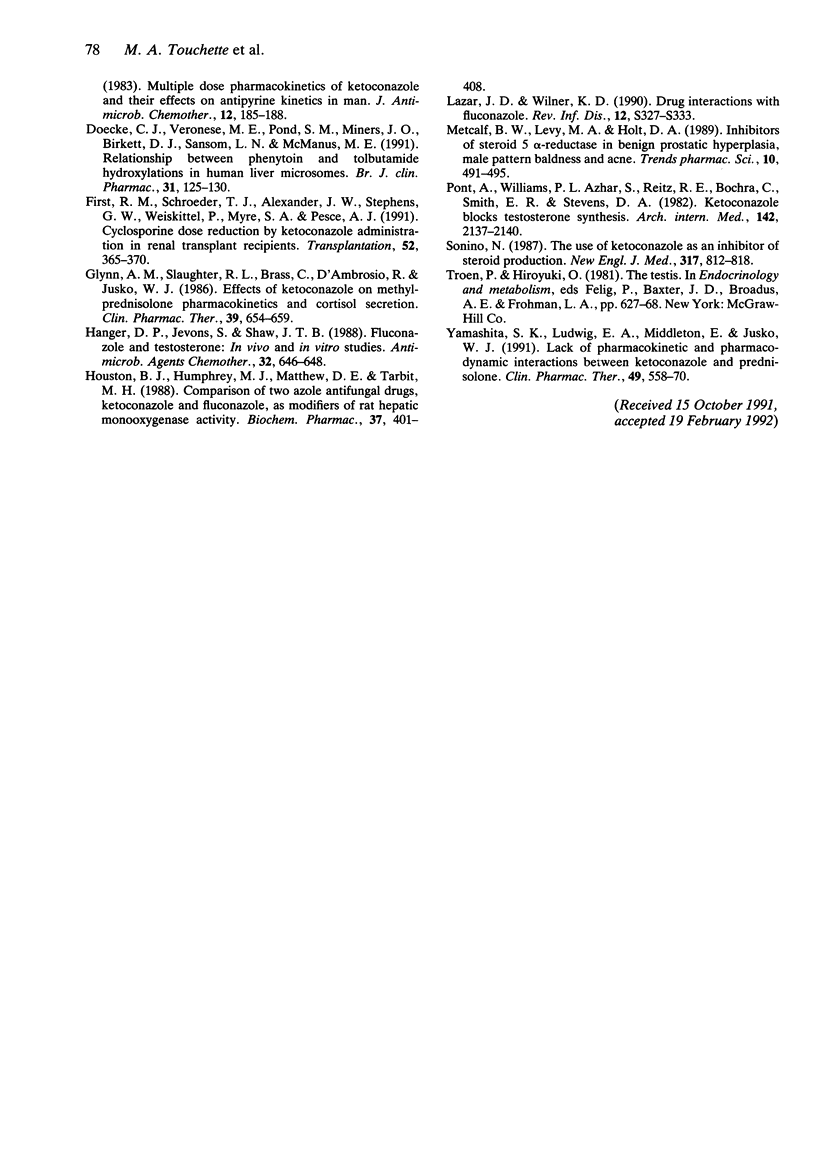Abstract
Nine healthy male subjects received oral fluconazole 400 mg daily, ketoconazole 200 mg twice daily or no treatment for 6 days according to a randomized, cross-over design. A single 250 mg oral dose of phenytoin suspension was administered on day 5 and serum phenytoin concentrations were measured over the following 48 h. Serum testosterone concentrations were measured for 10 h after each dose of phenytoin. Ketoconazole had no significant effect on phenytoin concentrations while the mean AUC(0,48) for phenytoin was significantly higher with fluconazole (195.2 +/- 47.8 micrograms ml-1 h) than control (146.3 +/- 49.6 micrograms ml-1 h). At 48 h, the serum phenytoin concentration averaged 1.72 micrograms ml-1 under control conditions and 3.99 micrograms ml-1 with fluconazole (132% increase). AUC(0,10) for testosterone was 42% lower than control after ketoconazole administration (P less than 0.05) but increased by 33% from 55.6 +/- 9.4 ng ml-1 h (control) to 73.8 +/- 12.6 ng ml-1 h with fluconazole. AUC(0,10) values for the testosterone precursors androstenedione and 17 alpha-hydroxyprogesterone were significantly higher in the fluconazole treatment phase as were concentrations of luteinizing hormone. The mechanism and clinical significance of the increase in testosterone concentration caused by fluconazole remains to be determined.
Full text
PDF



Selected References
These references are in PubMed. This may not be the complete list of references from this article.
- Back D. J., Tjia J. F. Comparative effects of the antimycotic drugs ketoconazole, fluconazole, itraconazole and terbinafine on the metabolism of cyclosporin by human liver microsomes. Br J Clin Pharmacol. 1991 Nov;32(5):624–626. doi: 10.1111/j.1365-2125.1991.tb03963.x. [DOI] [PMC free article] [PubMed] [Google Scholar]
- Blum R. A., Wilton J. H., Hilligoss D. M., Gardner M. J., Henry E. B., Harrison N. J., Schentag J. J. Effect of fluconazole on the disposition of phenytoin. Clin Pharmacol Ther. 1991 Apr;49(4):420–425. doi: 10.1038/clpt.1991.49. [DOI] [PubMed] [Google Scholar]
- Brown M. W., Maldonado A. L., Meredith C. G., Speeg K. V., Jr Effect of ketoconazole on hepatic oxidative drug metabolism. Clin Pharmacol Ther. 1985 Mar;37(3):290–297. doi: 10.1038/clpt.1985.42. [DOI] [PubMed] [Google Scholar]
- Canafax D. M., Graves N. M., Hilligoss D. M., Carleton B. C., Gardner M. J., Matas A. J. Increased cyclosporine levels as a result of simultaneous fluconazole and cyclosporine therapy in renal transplant recipients: a double-blind, randomized pharmacokinetic and safety study. Transplant Proc. 1991 Feb;23(1 Pt 2):1041–1042. [PubMed] [Google Scholar]
- Doecke C. J., Veronese M. E., Pond S. M., Miners J. O., Birkett D. J., Sansom L. N., McManus M. E. Relationship between phenytoin and tolbutamide hydroxylations in human liver microsomes. Br J Clin Pharmacol. 1991 Feb;31(2):125–130. doi: 10.1111/j.1365-2125.1991.tb05499.x. [DOI] [PMC free article] [PubMed] [Google Scholar]
- First M. R., Schroeder T. J., Alexander J. W., Stephens G. W., Weiskittel P., Myre S. A., Pesce A. J. Cyclosporine dose reduction by ketoconazole administration in renal transplant recipients. Transplantation. 1991 Feb;51(2):365–370. doi: 10.1097/00007890-199102000-00018. [DOI] [PubMed] [Google Scholar]
- Glynn A. M., Slaughter R. L., Brass C., D'Ambrosio R., Jusko W. J. Effects of ketoconazole on methylprednisolone pharmacokinetics and cortisol secretion. Clin Pharmacol Ther. 1986 Jun;39(6):654–659. doi: 10.1038/clpt.1986.114. [DOI] [PubMed] [Google Scholar]
- Hanger D. P., Jevons S., Shaw J. T. Fluconazole and testosterone: in vivo and in vitro studies. Antimicrob Agents Chemother. 1988 May;32(5):646–648. doi: 10.1128/aac.32.5.646. [DOI] [PMC free article] [PubMed] [Google Scholar]
- Houston J. B., Humphrey M. J., Matthew D. E., Tarbit M. H. Comparison of two azole antifungal drugs, ketoconazole, and fluconazole, as modifiers of rat hepatic monooxygenase activity. Biochem Pharmacol. 1988 Feb 1;37(3):401–408. doi: 10.1016/0006-2952(88)90206-7. [DOI] [PubMed] [Google Scholar]
- Lazar J. D., Wilner K. D. Drug interactions with fluconazole. Rev Infect Dis. 1990 Mar-Apr;12 (Suppl 3):S327–S333. doi: 10.1093/clinids/12.supplement_3.s327. [DOI] [PubMed] [Google Scholar]
- Metcalf B. W., Levy M. A., Holt D. A. Inhibitors of steroid 5 alpha-reductase in benign prostatic hyperplasia, male pattern baldness and acne. Trends Pharmacol Sci. 1989 Dec;10(12):491–495. doi: 10.1016/0165-6147(89)90048-5. [DOI] [PubMed] [Google Scholar]
- Pont A., Williams P. L., Azhar S., Reitz R. E., Bochra C., Smith E. R., Stevens D. A. Ketoconazole blocks testosterone synthesis. Arch Intern Med. 1982 Nov;142(12):2137–2140. [PubMed] [Google Scholar]
- Sonino N. The use of ketoconazole as an inhibitor of steroid production. N Engl J Med. 1987 Sep 24;317(13):812–818. doi: 10.1056/NEJM198709243171307. [DOI] [PubMed] [Google Scholar]
- Yamashita S. K., Ludwig E. A., Middleton E., Jr, Jusko W. J. Lack of pharmacokinetic and pharmacodynamic interactions between ketoconazole and prednisolone. Clin Pharmacol Ther. 1991 May;49(5):558–570. doi: 10.1038/clpt.1991.66. [DOI] [PubMed] [Google Scholar]


